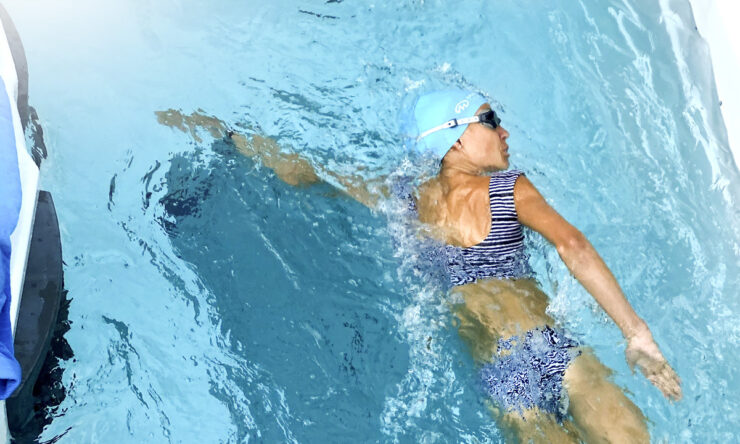Professional runner Jordan Hasay has been happy as she’s been logging miles on the trails of San Luis Obispo, California. And it’s not just because the city is known as one of America’s happiest cities. Although, it’s hard to compete with the weather, laid-back vibe, and stunning landscape. The city sits between Los Angeles and San Francisco, and it has easy access to the Pacific Ocean and Santa Lucia Mountains. For Hasay, it’s also been the opportunity to get in a groove with training.
But it’s not just laps on the track or hill workouts in the mountains that are helping her get fit. Cross training has always been an important part of Hasay’s routine.
“I grew up swimming and always enjoyed it. In fact, the track coach had to write my parents a message to say he thought I should start coming to track practice more often than swimming!” Hasay says. “Even now as a professional runner, I incorporate swimming regularly. It helps to flush out my legs from the pounding and I just like the refreshing feeling of the water.”
Swimming doesn’t always mean laps in the pool for the California native. Hasay, a Master Spas brand ambassador, incorporates swim spa sessions when she’s at home.
A swim spa allows a swimmer — or runner like Hasay — to swim in place. With a variable speed system and temperature controls, you can swim at your pace in water that feels good. Swim spas also feature hydrotherapy jets (just like a hot tub) for recovery and relaxation.
Swimming and cross training for runners
What’s the best way to become a stronger, faster runner? The building blocks to improving fitness include weekly mileage, speedwork, and hill repeats. However, there are other components of a well-rounded training plan. Cross training and active recovery can help runners reach their goals.
Why is it important for runners to incorporate cross-training? It can build endurance and speed, while improving recovery time.
Among runners, swimming is a popular way to cross train. Not only is it low-impact but it provides a total body workout.
Swimming specifically helps runners by improving flexibility, strengthening the ankles, increasing lung capacity, and regulating breathing. Depending on the runner, another benefit of swimming can be building muscle.
Even when she’s running high mileage, Hasay incorporates swimming as cross training. It helps as she builds fitness and is important to her recovery.
Swimming basics for runners
When you want to start running, it can often be as simple as lacing up your shoes and heading out the door.
However, when runners want to start swimming, there’s more to consider than heading to the pool and putting on a swimsuit.
Swimming is a sport that requires technique, from a streamline body position to rotating as you breathe. For runners who don’t have a swimming background, there can be a learning curve to incorporating swimming as cross training.
“For runners looking to start swimming, I would recommend just starting with 5 to 10 minutes at a time on the evening of your hard runs,” Hasay says. “I find getting in the pool after my hard workouts is like therapy for my legs.
“If using the swim spa you can also finish with turning the jets on high and using that as a massage!”
Since these first swims are almost active recovery, you can keep the pace easy and focus on good mechanics.
Runners who don’t have a swimming background can also invest in swim lessons, whether it’s at the local pool or inviting a private coach to your swim spa.
Hasay’s pro swimming advice for runners
Swimming can often be seen as punishment for runners. Hitting the pool can often mean you are recovering from an injury or starting to feel the onset of an injury. However, swimming can be a way for runners to take their cross training to the next level.
Hasay, who grew up swimming, swims regularly. However, she adapts her cross-training routine based on where she’s at with running and racing.
She offers this advice to runners who want to begin swimming or swim more regularly.
Maintain cardio fitness during off season. “During the off season, I may get up to an hour of swimming five to six times a week. I like to mix up using the swim spa for the convenience of being at home versus meeting my friends at the local pool for an interval workout.
Cut back mileage during peak training. “As my mileage increases, I usually cut back the swimming,” Hasay says. “But even at peak mileage I swim three times at 15 minutes a week. The swim spa is great since you can set it in 15-minute intervals. I just set it to medium speed and have a nice easy swim.”
Incorporate interval training into your swims. “A great swim spa workout I like to do is a 15-minute warm-up, then 10 x 1-minute at high speed with about 30 seconds rest. The swim spa is a fun place to do this workout since I just jump in, swim, and float out for the rest!”
“Happy summer everyone and happy swimming!” Hasay says.
Swim your best, at home
Are you ready to incorporate swimming into your fitness routine? Having a Master Spas swim spa at home allows you to enjoy the benefits of a pool, while enjoying the relaxation and recovery of a hot tub. You can click here to get more backyard ideas and picture what a swim-in-place pool would look like in your space. Or, contact your local Master Spas retailer to learn more about swim spa ownership. Wondering how much a swim spa costs? You can request a quote here.

